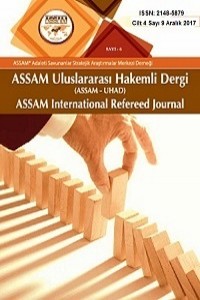BRICS ve MIST ÜLKELERİNDE YENİLENEBİLİR VE YENİLENEMEYEN ENERJİ TÜKETİMİNİN EKONOMİK BÜYÜME ÜZERİNDEKİ ETKİLERİ
Öz
Bu
çalışmada, BRICS (Brezilya, Rusya, Hindistan, Çin ve Güney Afrika) ve MIST
(Meksika, Endonezya, Güney Kore ve Türkiye) ülkelerinde 1992-2014 dönemi için
yenilenebilir ve yenilenemeyen enerji tüketiminin ekonomik büyüme üzerindeki
etkinliklerinin karşılaştırılması amaçlanmıştır. Bu amaç doğrultusunda
çalışmada panel eşbütünleşme ve panel nedensellik yöntemlerinden faydalanılmıştır.
Elde edilen ampirik bulgulara göre, ekonomik aktivitelerin hem yenilenebilir
hem de yenilenemeyen enerji tüketimlerinden pozitif yönde etkilendiği
görülmektedir. Ayrıca, yenilenemeyen enerji tüketiminin, yenilenebilir enerji
tüketimine göre ekonomik büyüme üzerinde daha etkin olduğu sonucuna
ulaşılmıştır. Panel nedensellik testi sonuçlarına göre ise ekonomik büyümeden
yenilenebilir enerji tüketimine doğru tek yönlü bir nedenselliğin geçerli
olduğu görülmüş ve bu enerji türü için tasarruf hipotezi kabul edilmiştir. Buna
karşın, yenilenemeyen enerji tüketimi ile ekonomik büyüme arasında çift yönlü
bir nedensellik ilişkisi tespit edilmiş ve bu enerji türü için büyüme
hipotezinin geçerli olduğu gözlemlenmiştir.
Anahtar Kelimeler
BRICS ve MIST Ülkeleri Yenilenebilir Ve Yenilenemeyen Enerji Ekonomik Büyüme
Kaynakça
- Akarca, A.T. ve Long, T.V., (1979). "Energy and employment: A time series analysis of the causal relationship." Resour. Energy. 5, 326-331
- Apergis N. ve Payne J.E. (2011). "Renewable and non-renewable electricity consumption– growth nexus: evidence from emerging market economies." Appl Energy 88:5226–30. Apergis N. ve Payne J.E., (2012). "Renewable and non-renewable energy consumption – growth nexus: evidence from a panel error correction model." Energy Econ.;34:733–8.
- Bhattacharya M., Paramati S.R, Ozturk I. ve Bhattacharya S., (2016). "The effect of renewable energy consumption on economic growth: evidence from top 38 countries." Appl Energy; 162:733–41.
- Destek, M. A. (2016). Natural gas consumption and economic growth: Panel evidence from OECD countries. Energy, 114, 1007-1015.
- Dumitrescu, E. I. ve Hurlin, C. (2012). "Testing for Granger non-causality in heterogeneous panels." Economic Modelling, 29(4), 1450-1460. Farhani S. ve Shahbaz M., (2014). "What role of renewable and non-renewable electricity consumption and output is needed to initially mitigate CO2 emissions in MENA region." Renew Sustain Energy Rev. 40: 80–90. Im K.S, Pesaran M.H. ve Shin Y., (2003). "Testing for unit roots in heterogeneous panels." J.Econ.; 115:53–74.
- Jebli M.B. ve Youssef S.B., (2015). "Output, renewable and non-renewable energy consumption and international trade: evidence from a panel of 69 countries." Renew Energy;83:799–808. Kao, C. (1999). "Spurious regression and residual-based tests for cointegration in panel data." Journal of econometrics, 90(1), 1-44. Kraft,J. ve Kraft, A., (1978). "On the relationship between energy and GNP." J.Energy Dev. 3, 401 403.
- Pao H, Li Y., ve Fu H., (2014). "Clean energy, non-clean energy, and economic growth in the MIST countries." Energy Policy;67:932–42.
- Payne JE., (2009). "On the dynamics of energy consumption and output in the US." Appl Energy 86:575–7. Pedroni P., (2000). "Fully modified OLS for heterogeneous cointegrated panels." Adv. Econ.; 15: 93–130. Tiwari, A.K., Apergis, N. ve Olayeni, O.R., (2015). "Renewable and nonrenewable energy production and economic growth in sub-Saharan Africa: A hidden cointegration analysis." Applied Economics 47(9) 861-882.
- Tugcu C.T, Ozturk I. ve Aslan A., (2012). "Renewable and non-renewable energy consumption and economic growth relationship revisited: evidence from G7 countries." Energy Econ. ;34:1942–50.
Öz
Kaynakça
- Akarca, A.T. ve Long, T.V., (1979). "Energy and employment: A time series analysis of the causal relationship." Resour. Energy. 5, 326-331
- Apergis N. ve Payne J.E. (2011). "Renewable and non-renewable electricity consumption– growth nexus: evidence from emerging market economies." Appl Energy 88:5226–30. Apergis N. ve Payne J.E., (2012). "Renewable and non-renewable energy consumption – growth nexus: evidence from a panel error correction model." Energy Econ.;34:733–8.
- Bhattacharya M., Paramati S.R, Ozturk I. ve Bhattacharya S., (2016). "The effect of renewable energy consumption on economic growth: evidence from top 38 countries." Appl Energy; 162:733–41.
- Destek, M. A. (2016). Natural gas consumption and economic growth: Panel evidence from OECD countries. Energy, 114, 1007-1015.
- Dumitrescu, E. I. ve Hurlin, C. (2012). "Testing for Granger non-causality in heterogeneous panels." Economic Modelling, 29(4), 1450-1460. Farhani S. ve Shahbaz M., (2014). "What role of renewable and non-renewable electricity consumption and output is needed to initially mitigate CO2 emissions in MENA region." Renew Sustain Energy Rev. 40: 80–90. Im K.S, Pesaran M.H. ve Shin Y., (2003). "Testing for unit roots in heterogeneous panels." J.Econ.; 115:53–74.
- Jebli M.B. ve Youssef S.B., (2015). "Output, renewable and non-renewable energy consumption and international trade: evidence from a panel of 69 countries." Renew Energy;83:799–808. Kao, C. (1999). "Spurious regression and residual-based tests for cointegration in panel data." Journal of econometrics, 90(1), 1-44. Kraft,J. ve Kraft, A., (1978). "On the relationship between energy and GNP." J.Energy Dev. 3, 401 403.
- Pao H, Li Y., ve Fu H., (2014). "Clean energy, non-clean energy, and economic growth in the MIST countries." Energy Policy;67:932–42.
- Payne JE., (2009). "On the dynamics of energy consumption and output in the US." Appl Energy 86:575–7. Pedroni P., (2000). "Fully modified OLS for heterogeneous cointegrated panels." Adv. Econ.; 15: 93–130. Tiwari, A.K., Apergis, N. ve Olayeni, O.R., (2015). "Renewable and nonrenewable energy production and economic growth in sub-Saharan Africa: A hidden cointegration analysis." Applied Economics 47(9) 861-882.
- Tugcu C.T, Ozturk I. ve Aslan A., (2012). "Renewable and non-renewable energy consumption and economic growth relationship revisited: evidence from G7 countries." Energy Econ. ;34:1942–50.
Ayrıntılar
| Bölüm | Makale |
|---|---|
| Yazarlar | |
| Yayımlanma Tarihi | 25 Aralık 2017 |
| Gönderilme Tarihi | 10 Haziran 2017 |
| Yayımlandığı Sayı | Yıl 2017 Cilt: 4 Sayı: 9 |
ASSAM-UHAD Nisan ve Kasım aylarında yayınlanan süreli ve elektronik basımı yapılan, uluslararası indeksli hakemli bir dergidir.


